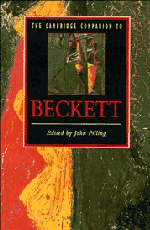Book contents
- Frontmatter
- 1 An endgame of aesthetics
- 2 Beckett's English fiction
- 3 Three novels and four nouvelles
- 4 Waiting for Godot and Endgame
- 5 Stages of identity
- 6 Beginning again
- 7 The mediated Quixote
- 8 Dead heads
- 9 Disabled figures
- 10 Beckett's poems and verse translations or
- 11 Beckett as director
- 12 Beckett's bilingualism
- 13 Beckett and the philosophers
- Further reading
- Index
9 - Disabled figures
from the Residua to Stirrings still
Published online by Cambridge University Press: 28 May 2006
- Frontmatter
- 1 An endgame of aesthetics
- 2 Beckett's English fiction
- 3 Three novels and four nouvelles
- 4 Waiting for Godot and Endgame
- 5 Stages of identity
- 6 Beginning again
- 7 The mediated Quixote
- 8 Dead heads
- 9 Disabled figures
- 10 Beckett's poems and verse translations or
- 11 Beckett as director
- 12 Beckett's bilingualism
- 13 Beckett and the philosophers
- Further reading
- Index
Summary
Beyond How it is Samuel Beckett's prose fiction is marked by a series of techniques or strategies brought to bear upon the work in order to perpetuate it. That is, the processes of self-reduction which are formally evident in the late prose texts become the very subject of the texts themselves. This reductionist tendency is not, however, simply a condensing of stylistic detail, but may be observed within the motivation of the prose's content. The late prose texts become increasingly interconnected and self-referential. One text literally generates another. A text may 'defeat' another, in the manner of Enough's opening exhortation, '[a]ll that goes before forget' (GSP, 139), or the torn sheet of writing in As the story was told (AST, 196). Conversely (but amounting to much the same thing) the text may compulsively repeat what has already been written. One might suggest, for example, that Imagination dead imagine evolved, or devolved, from All strange away. Resorting to manuscript materials may support this, but the evidence lies embedded within the texts themselves. The latter text even opens with the title of the former. Again, it is important to emphasize that this is not simply a stylistic resonance, but a re-negotiation of something altogether more solid. It is as if the written has become three dimensional, and must be assimilated from all sides. A return to the text, therefore, will always be a complex repetition, taken at tangents to the original narrative.
- Type
- Chapter
- Information
- The Cambridge Companion to Beckett , pp. 167 - 183Publisher: Cambridge University PressPrint publication year: 1994
- 3
- Cited by



